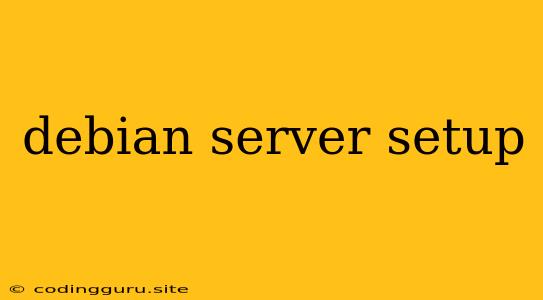Setting Up a Debian Server: A Comprehensive Guide
Setting up a Debian server can seem daunting, but it's a rewarding experience that gives you complete control over your infrastructure. This guide walks you through the essential steps for a successful Debian server setup, from initial installation to essential configuration.
1. Choosing the Right Debian Version:
The first step is to choose the appropriate Debian version for your server. Debian offers stable, testing, and unstable branches. For most users, the stable branch is the recommended choice. It prioritizes stability and reliability, making it ideal for production environments. The testing branch receives updates more frequently and offers newer software but might encounter occasional bugs. The unstable branch is for developers and those who want the most recent software but should only be used if you're comfortable with instability and potential issues.
2. Obtaining the Installation Media:
You can download the official Debian installer image from the Debian website. The website offers various options, including ISO images and netboot images. The ISO image can be written to a USB drive or burned to a DVD, while the netboot image requires a network connection during installation.
3. Booting from the Installation Media:
After creating the installation media, boot your server from it. You'll be presented with the Debian installer. Select the language, keyboard layout, and network settings. You'll also be asked to choose the installation type.
4. Choosing the Installation Type:
The installation type determines how Debian is installed. You can choose between a guided installation (recommended for beginners) or a manual installation. The guided installation simplifies the process by automatically configuring common settings, while the manual installation gives you greater control.
5. Configuring the Server's Partitions:
The installation process will guide you through partitioning your hard drive. Consider allocating space for the root partition (where the operating system files are stored), a separate partition for the /home directory (where user data is stored), and a swap partition (used by the system as virtual RAM).
6. Setting Up the Network:
During the installation, you'll need to configure your server's network settings. This includes choosing the network interface, specifying IP addresses, and setting up DNS.
7. Configuring the Root Password:
The first time you install Debian, you'll be prompted to create a strong password for the root user (the superuser account). This password is essential for managing the server.
8. Installing Basic Packages:
After the installation completes, you'll have a basic Debian server. You can install additional packages using the apt package manager. For example, you can install a web server, a database, or any other software that your server needs.
9. Securing Your Debian Server:
Securing your server is crucial to protect it from unauthorized access and malicious attacks. Here are some essential security measures:
- Disable unnecessary services: Identify and disable any services that are not essential for your server's operation.
- Create a strong firewall: Configure a firewall (like
ufworiptables) to block unauthorized traffic. - Keep software updated: Regularly update your server's software and operating system using the
apt updateandapt upgradecommands.
10. Managing Your Server:
After setting up your Debian server, you'll need to manage it. This includes tasks like monitoring the system, restarting services, and managing users. You can use the command line interface (CLI) or a remote desktop tool like SSH for this purpose.
Essential Server Tools:
- SSH (Secure Shell): A secure protocol for remote access to your server.
- Apache or Nginx: Popular web server software.
- MySQL or PostgreSQL: Relational database management systems.
- Firewall (ufw or iptables): Protect your server from unauthorized access.
- Monitoring Tools (Nagios or Zabbix): Keep track of your server's health.
Conclusion:
Setting up a Debian server empowers you with complete control over your infrastructure. It provides a stable and secure platform for hosting web applications, running databases, and managing various other services. By following the steps in this guide, you can successfully create a Debian server that meets your needs. Remember to prioritize security, regularly update your system, and learn more about managing your Debian server for optimal performance and security.
